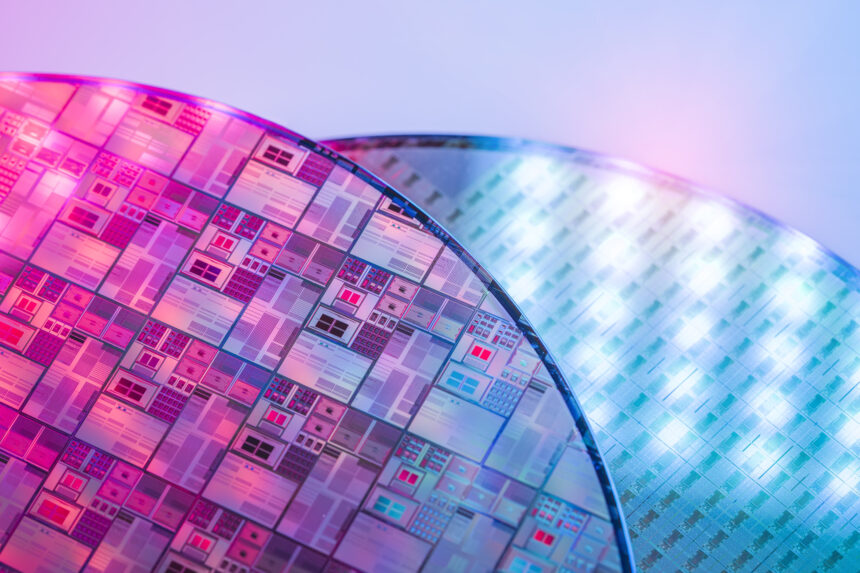TSMC’s early adoption of those EUV systems, which optically etch circuit patterns onto the world’s smallest chips, helped it pull ahead of Intel in the process race to manufacture more power-efficient chips. It also gained Apple as its top customer and attracted a lot more attention from fabless chipmakers like Nvidia, Advanced Micro Devices, and Qualcomm.
Apple’s shift to TSMC curbed its dependence on Samsung, which had rapidly evolved from its leading supplier into a major competitor in the smartphone market. It also supported its production of first-party chips and reduced its dependence on third-party components.
Over the past 10 years, TSMC’s stock has soared 716% and boosted its market cap to $885 billion. Apple’s stock rallied 793% and lifted its valuation to $3.47 trillion. But could TSMC become the more valuable tech giant by 2030?
From 2016 to 2023, TSMC’s revenue grew at a compound annual growth rate (CAGR) of 13%, while its earnings per share (EPS) increased at a CAGR of 15%. Most of that growth was driven by the expanding smartphone market. It also thrived throughout the pandemic as more workers upgraded their PCs for remote work and online classes, while the growth of the artificial intelligence (AI) market spurred the market’s demand for new data center chips.
As the world’s largest contract chipmaker, TSMC’s sales usually ebb and flow with the semiconductor sector’s cyclical growth cycles. Its growth decelerated in 2018 and 2019 as the memory chip market cooled off, and its revenue declined in 2023 as the 5G upgrade cycle ended and global PC shipments declined.
But this year, TSMC expects the growth of the AI market, rising smartphone sales, and the stabilizing PC market to lift its sales again. In the second quarter of 2024, it generated 52% of its revenue from the high-performance computing (HPC) market — which includes Nvidia, AMD, and other AI chipmakers. That segment grew 28% sequentially, outpacing all its other end markets. Its smartphone revenue, which still accounted for 33% of its top line, dipped 1% sequentially.
Analysts expect TSMC’s revenue to increase 30% in 2024, 24% in 2025, and 18% in 2026, and for its EPS to grow at a CAGR of 25% from 2023 to 2026. But to maintain that momentum, TSMC will need to successfully ramp up the production of its 3-nanometer (nm) chips and start manufacturing its newest 2nm chips by early 2025.
If TSMC sticks to that schedule, it should maintain its lead in the closely watched process race. It will also remain the linchpin and bellwether of the semiconductor sector for the foreseeable future. However, its growth could still be disrupted by a recession; a conflict between China, the U.S., and Taiwan; and Intel’s loss-leading expansion of its first-party foundries.
Assuming TSMC matches Wall Street’s expectations, grows its EPS at a CAGR of 20% from 2026 to 2031, and still trades at 22 times forward earnings by the beginning of 2030, its stock could reach about $550 per share. That would represent a 220% gain from its current price, but it would only boost its market cap to about $2.85 trillion.
That would still make TSMC less valuable than today’s Apple. Apple might face some headwinds through the end of the decade as its iPhone sales cool off and regulatory headwinds curb the growth of its services segment. However, I believe it could easily grow its EPS at a steady CAGR of at least 15% from fiscal 2023 (which ended last September) through fiscal 2031 as it ramps up its massive buybacks. If it merely clears that lowest bar and keeps trading at a reasonable 20 times forward earnings, its stock could rise to about $350 by 2030. That would boost its market cap by more than 50% to $5.35 trillion.
So, for now, it’s unlikely that TSMC’s market cap will eclipse Apple’s by 2030. That said, TSMC might still outperform Apple as an investment as it benefits from the broader expansion of the broader semiconductor market. Apple still has plenty of irons in the fire, but it faces much tougher competitive and regulatory challenges than TSMC.



